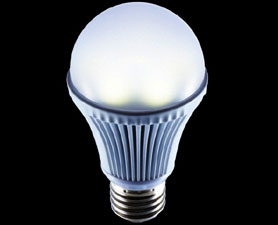
A ceiling full of blinking LEDs could help produce much more than just light.
Regular light bulbs straight from the shelf could be the future of wireless technology.
Energy-efficient light-emitting diodes (LED) have long been eyed as a convenient replacement for energy to supply wireless networks. Labs and startups are producing custom-built LED prototypes with high-speed data transmission capabilities, but German researchers successfully converted light bulbs that come right off the shelf.
A ceiling full of blinking LEDs could help produce much more than just light.
Regular light bulbs straight from the shelf could be the future of wireless technology.
Energy-efficient light-emitting diodes (LED) have long been eyed as a convenient replacement for energy to supply wireless networks. Labs and startups are producing custom-built LED prototypes with high-speed data transmission capabilities, but German researchers successfully converted light bulbs that come right off the shelf.
 "These are high-brightness, white LEDs which normally are used for illumination," said Anagnostis Paraskevopoulos, a research engineer at the Fraunhofer Institute for Telecommunications in
"These are high-brightness, white LEDs which normally are used for illumination," said Anagnostis Paraskevopoulos, a research engineer at the Fraunhofer Institute for Telecommunications in
NEWS: LED Wallpaper Gets Green Light
If used widely, the technology not only creates a vast new application for light, but could also expand our limited wireless capacity.
Paraskevopoulos and his colleagues made a slight change to the LED circuitry with a simple modulator that enables the device to transfer data optically, he said. The LED flickers, but in a way that's far too fast for human eyes to perceive. They were able to transmit data from lights in the ceiling fast enough to send four high-definition videos to four laptops simultaneously.
This optical approach to data transmission is viewed as a sustainable form of communication that doesn't create electromagnetic interference at low frequencies, like the current wireless networks do, which would be beneficial for some areas like airports.
And with the cost of LEDs expected to continue going down, they're likely to be a more economically viable option in the future.
Research is also focused on LEDs because they offer several advantages over compact fluorescent lamps and incandescents. Solid state lighting devices, smart lighting researchers argue, are better for the environment because they don’t contain substances like mercury or phosphor. They won't smash when dropped, and have the capacity to last for tens of years.
Researchers from around the world, including the
The Fraunhofer researchers want to show the lighting industry how easily it can be done. They will be exhibiting their prototypes at the international IFA consumer electronics trade show in
"You have a device which will be integrated into office or household environments," he said. "Then you have an interesting add-on."
NEWS: LED Lighting Makes Food Look More Appetizing
Mohsen Kavehrad is a professor of electrical engineering at
The quality of light from LEDs is comparable to any other light source and is actually healthier due to better color control, Kavrehad said. 'There is a lot of research being put into these by companies like Philips and others to make sure that they can match the sunlight."
So, what happens when you turn the lights off?
"This is one of the many areas they are still doing research on," Kavehrad said. "There are many ways to make it work. Number one is to dim the light and be able to continue communication. The better deal is to simply package an infrared LED source along with the visible light and then if you turn off the visible at night, the infrared can continue working and you won’t be able to see it. These have all been worked on. These problems have been considered by others as well. It’s all other work. What you will get ultimately works whether the light is on or off."
The lighting production cycle is usually several years, but if the industry goes for it, mass producing smart LEDs could happen in under five, he added.
"The technology is available and doable, as the Germans have shown," Kavehrad said. "It's an important step."

 Previous page
Previous page Back to top
Back to top







